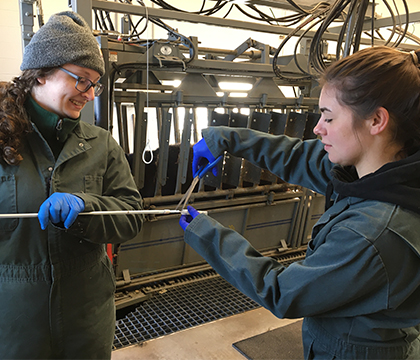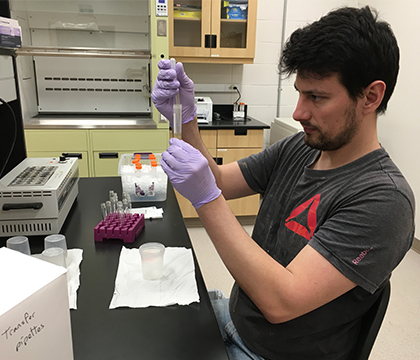The Livestock and Forage Centre of Excellence builds on Saskatchewan’s rich pedigree of research and teaching in livestock and forage production. At this unique centre, USask scientists in agriculture, veterinary medicine and engineering have access to new facilities and technologies, larger herds and additional acres of forage and grazing land— all near Saskatoon. As researchers go further in their discoveries, they will find new ways to improve the global food chain.
Pooling all of this research power not only benefits livestock producers and the agriculture industry. Undergraduate and graduate students gain valuable, hands-on experience and opportunities to participate in cutting-edge research investigations. In addition, the LFCE is positioned to attract world leaders in beef and forage research to collaborate on a wide range of projects.
If you are interested in carrying out a research project at the LFCE, please contact the centre's director Dr. Scott Wright (PhD) at scott.wright@usask.ca. The first step to conducting research at the centre is to complete a Notification of Intent to Conduct Research Using LFCE Assets. It’s critical that this be completed during the planning phase of your project and submitted to Dr. Wright for review.



Current Research
-
Precision management of cattle manure
Dr. Jeff Schoenau (PhD), principal investigator -
Using high-moisture corn for finishing cattle and pregnant cattle
Dr. Greg Penner (PhD), principal investigator -
Quantifying crop water use and water-use productivity
Dr. Warren Helgason (PhD), Dr. Phillip Harder (PhD) and Dr. John W. Pomeroy (PhD), principal investigators -
Environmental research at an intensive cattle feeding operation
Dr. Terry Fonstad (PhD), principal investigator - Field backgrounding of beef calves
Dr. Bart Lardner (PhD) and Travis Peardon (Sask. Agriculture), principal investigators - Quantifying greenhouse gas emissions from beef cattle urine and dung in grazed pasture sod-seeded with non-bloat legumes
Dr. Richard Farrell (PhD), principal investigator - Effects of environmental and pollution stressors on avian cognition and migratory behaviour
Dr. Christy Morrissey (PhD), principal investigator - Performance, environmental and economic benefits of biochar supplementation in beef cattle grazing systems
Dr. Bart Lardner (PhD), principal investigator - Effects of annual and perennial forage systems on plant, soil and water parameters, grazing animal performance and system economics
Dr. Bart Lardner (PhD), principal investigator - Evaluating preference grazing and persistence of new forage varieties, and the effect of animal temperament on grazing behavior
Dr. Bart Lardner (PhD), principal investigator
- Inducing higher germination in Cicer milkvetch
Dr. Karen Tanino (PhD), principal investigator
- Developing native and tame forage varieties and mixtures
Dr. Bill Biligetu (PhD) and Dr. Mike Schellenberg (PhD), principal investigators
- Developing new sainfoin varieties
Dr. Bill Biligetu (PhD), Dr. Surya Acharya (PhD) and Dr. Doug Cattani (PhD), principal investigators
- Enhancing the use of wheat grain in feedlot diets
Dr. Pierre Hucl (PhD) and Dr. Tim McAllister (PhD), principal investigators
- The forage-efficient beef cow: investigating the underlying physiology
Dr. Greg Penner (PhD), principal investigator - Effects of annual and perennial forage systems on plant, soil and water parameters, grazing animal performance and system economics
Dr. Bart Lardner (PhD), principal investigator - Evaluating preference grazing and persistence of new forage varieties, and the effect of animal temperament on grazing behavior
Dr. Bart Lardner (PhD), principal investigator - Evaluation of alfalfa and grass species in binary and triple mixtures on performance under soil salinity conditions
Dr. Bart Lardner (PhD), principal investigator
- Genomic ASSETS for Livestock
Dr. Cheryl Waldner and Dr. Simon Otto, principal investigators
- Genetic and genomic factors influencing gestational length in beef cattle
Dr. Mika Asai-Coakwell (PhD), principal investigator
- The forage-efficient beef cow: investigating the underlying physiology
Dr. Greg Penner (PhD), principal investigator
-
Using high-moisture corn for finishing cattle and pregnant cattle
Dr. Greg Penner (PhD), principal investigator - The forage-efficient beef cow: investigating the underlying physiology
Dr. Greg Penner (PhD), principal investigator - Evaluating local anesthetic to improve pain control in beef calves undergoing castration
Dr. Diego Moya (DVM, PhD), principal investigator
- Enhancing the use of wheat grain in feedlot diets
Dr. Pierre Hucl (PhD) and Dr. Tim McAllister (PhD), principal investigators - Determining the minimum fibre requirement for feedlot cattle
Dr. Greg Penner (PhD) and Dr. Katie Wood (PhD), principal investigators - Using high-moisture corn for finishing cattle and pregnant cattle
Dr. Greg Penner (PhD), principal investigator - Field backgrounding of beef calves
Dr. Bart Lardner (PhD) and Travis Peardon (Sask. Agriculture), principal investigators - The forage-efficient beef cow: investigating the underlying physiology
Dr. Greg Penner (PhD), principal investigator - Using sensory additives to boost feed intake and immune function of newly arrived feedlot cattle
Dr. Diego Moya (DVM, PhD), principal investigator - Effects of annual and perennial forage systems on plant, soil and water parameters, grazing animal performance and system economics
Dr. Bart Lardner (PhD), principal investigator
- Enhancing the use of wheat grain in feedlot diets
Dr. Pierre Hucl (PhD) and Dr. Tim McAllister (PhD), principal investigators - Determining the minimum fibre requirement for feedlot cattle
Dr. Greg Penner (PhD) and Dr. Katie Wood (PhD), principal investigators - Using high-moisture corn for finishing cattle and pregnant cattle
Dr. Greg Penner (PhD), principal investigator - Field backgrounding of beef calves
Dr. Bart Lardner (PhD) and Travis Peardon (Sask. Agriculture), principal investigators - Delivering a respiratory probiotic to feedlot cattle via feed
Dr. Murray Jelinski (DVM), principal investigator - Investigating the role of flooring in the development of Toe Tip Necrosis Syndrome
Dr. Murray Jelinski (DVM), principal investigator - Investigating the use of a probiotic to control Mycoplasma bovis infections
Dr. Murray Jelinski (DVM), principal investigator - Using sensory additives to boost feed intake and immune function of newly arrived feedlot cattle
Dr. Diego Moya (DVM, PhD), principal investigator - Evaluating local anesthetic to improve pain control in beef calves undergoing castration
Dr. Diego Moya (DVM, PhD), principal investigator
- Genomic ASSETS for Livestock
Dr. Cheryl Waldner and Dr. Simon Otto, principal investigators - Enhancing the use of wheat grain in feedlot diets
Dr. Pierre Hucl (PhD) and Dr. Tim McAllister (PhD), principal investigators - Determining the minimum fibre requirement for feedlot cattle
Dr. Greg Penner (PhD) and Dr. Katie Wood (PhD), principal investigators - Using high-moisture corn for finishing cattle and pregnant cattle
Dr. Greg Penner (PhD), principal investigator - Field backgrounding of beef calves
Dr. Bart Lardner (PhD) and Travis Peardon (Sask. Agriculture), principal investigators - Delivering a respiratory probiotic to feedlot cattle via feed
Dr. Murray Jelinski (DVM), principal investigator - Investigating the role of flooring in the development of Toe Tip Necrosis Syndrome
Dr. Murray Jelinski (DVM), principal investigator - Investigating the use of a probiotic to control Mycoplasma bovis infections
Dr. Murray Jelinski (DVM), principal investigator - Using sensory additives to boost feed intake and immune function of newly arrived feedlot cattle
Dr. Diego Moya (DVM, PhD), principal investigator
-
Enhancing the use of wheat grain in feedlot diets
Dr. Pierre Hucl (PhD) and Dr. Tim McAllister (PhD), principal investigators -
Determining the minimum fibre requirement for feedlot cattle
Dr. Greg Penner (PhD) and Dr. Katie Wood (PhD), principal investigators -
Using high-moisture corn for finishing cattle and pregnant cattle
Dr. Greg Penner (PhD), principal investigator
- Field backgrounding of beef calves
Dr. Bart Lardner (PhD) and Travis Peardon (Sask. Agriculture), principal investigators
- Development of germplasm biobank for Canadian bison
Dr. Gregg Adams (DVM, PhD), principal investigator
More to come
Completed Research
More to come
More to come
More to come
- Improving reproductive efficiency in beef cattle
Dr. Gregg Adams (DVM, PhD), principal investigator
More to come
- Improving reproductive efficiency in beef cattle
Dr. Gregg Adams (DVM, PhD), principal investigator
More to come
More to come
More to come
More to come
More to come
More to come
Graduate Theses
- Biosecurity and bovine respiratory disease on beef operations in western Canada
Trenton Richard Wennekamp, M. Sc., 2020 -
Use of an aromatase inhibitor for ovarian synchronization in cattle
Eric M. Zwiefelhofer, PhD., 2020
Archives - Western Beef Development Centre
- Performance and System Cost of Beef Cows Winter Grazing Barley Crop Residue Being Supplemented with Canola Meal or Wheat-Based Dried Distiller's Grain with Solubles (wDDGS)
- Reproduction and Feed Efficiency in Beef Heifers
- Evaluation of Progeny Performance Using Carcass Data From Beef InfoExchange System (BIXS)
- A Comparison of Zero-Till Seed Openers for Sod-Seeding Alfalfa for Pasture Rejuvenation
- Effect of Development System on Growth and Reproductive Performance of Beef Heifers
- Comparison of Different Herbicide Options to Control Absinth (Artemisia absinthium L.)
in Perennial Pasture - Economics of Raising Beef Replacement Heifers
- Time of Calving and Feeding Strategy Effects on Performance of Feeder Steers
- Winter Grazing Beef Cows with Standing Corn
- Raising Replacements - What is the Cost?
- 2011 Saskatchewan Cow/Calf Cost of Production Analysis
- 2011 Saskatchewan Low-Cost Cow-Calf Analysis
- 2011 Saskatchewan Cow-Calf Cost of Production by Herd Size
- Economics of Time of Calving and Feeding Strategy
Western Canadian Cow-Calf Survey
About the Survey
The Western Canadian Cow-Calf Survey (WCCCS) was an industry-led survey carried out in 2014 and 2017. The survey was an initiative led by the Western Beef Development Centre and involved collaborations with producer associations and provincial extension specialists in western Canada. The aim of the survey was to better understand the management practices followed by cow-calf producers and to collect production information to generate benchmarks for producers to compare to. Similar surveys have been conducted in Ontario, Quebec and Atlantic Canada with all results summarized in the 2019 Adoption Rates of Recommended Management Practices report by the Beef Cattle Research Council.
The questions asked in the WCCCS were based off previous producer surveys such as the "Alberta Beef Herd Analysis" conducted by Alberta Agriculture from 1998 to 1998. A report summarizing findings for Alberta’s survey can be found by clicking on the title below.
Production Indicators and Management Practices from 1988 to 1998
2014 Survey
Using the 1998 survey as a starting point, a new survey was developed with questions related to the 2013 breeding until 2014 weaning time frame. The survey was expanded to all cow-calf producers from British Columbia to Manitoba. Producers had the option to complete a paper copy of the survey or an online version. Everyone's individual results remain confidential, but they are aggregated to generate productivity and management practice benchmarks that are widely shared with industry.
WCCCS I - Production Indicator Report
2017 Survey
The second WCCCS survey was conducted during fall/winter 2017/18. In 2017, both Ontario and Atlantic Canada conducted similar surveys. The survey asked questions related to the 2016 breeding season until weaning of the 2017-born calves plus questions on management practices.As with the 2014 survey, the 2017 survey was a collaborative effort between producer associations, provincial governments and research organizations.
Funding Sources
The 2017 survey would not have been possible without the financial conribution provided by the Saskatchewan Ministry of Agiculture and the Canada-Saskatchewan Growing Forward 2 Bi-Lateral Agreement and the Saskatchewan Cattlemen's Association Industry Development Fund.
The researchers thank the Saskatchewan Ministry of Agriculture's Agriculture Development Fund and Agriculture Canada's Growing Forward II through Alberta Agriculture and Rural Development for providing financial support to assist in conducting the survey in 2014.

